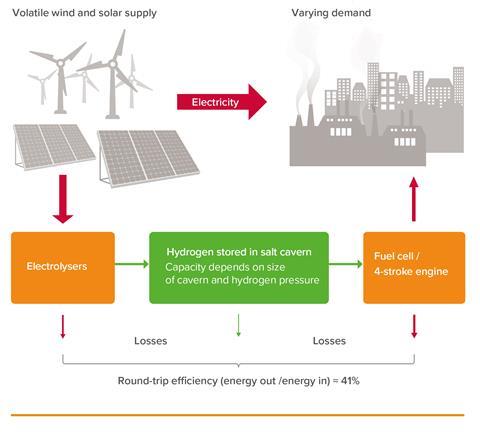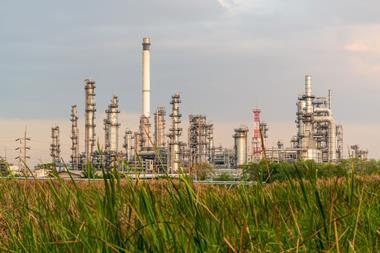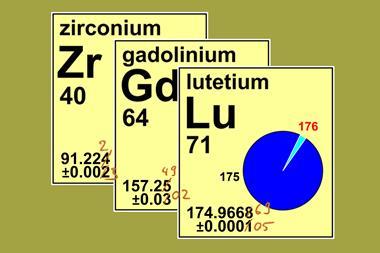Construction of large-scale hydrogen storage facilities needs to begin immediately if the UK government is to have any chance of meeting its net zero targets, a report by the Royal Society has concluded. Storing hydrogen in closed salt mines would be the best way to meet the country‘s long-term storage needs as it has the lowest cost per unit of energy storage capacity, it adds.
The UK government has committed to decarbonising the electricity system by 2035 and reaching net zero by 2050. As the national grid is being decarbonised, an increasing fraction of the nation’s electricity is being supplied by wind and solar energy – the cheapest low-carbon energy. However, there will be times when the intermittent nature of wind and solar power will mean that demand outstrips supply and back-up energy sources will be needed.
The report examines a wide variety of ways to store surplus wind and solar generated electricity – including green hydrogen, advanced compressed air energy storage, ammonia and heat – which will be needed to ensure energy security when the sun is not shining, and the wind is not blowing.
Nuclear power and burning biomass and capturing the carbon dioxide may also play a role, the report says. However, these forms of generation are expensive, especially if operated with the flexibility needed to complement fluctuations in wind and solar power.
‘To ensure that demand is always met, the volatile wind and solar generated electricity that is fed directly into the grid must be complemented by other flexible low-carbon sources, and/or using excess wind and solar energy that has been stored,’ the report reads. ‘The excess could be stored in a variety of ways, for example electrochemically in batteries, gravitationally by pumping water into dams, mechanically by compressing air, chemically by making hydrogen, or as heat.’
The most promising method to store energy, the report says, is to use electrolysers to convert wind and solar-generated electricity into hydrogen, which can then be stored in solution-mined salt caverns. The UK has plenty of old sites that could be used for underground hydrogen storage, it adds, although the mines are limited to East Yorkshire, Cheshire and Wessex, and constructing enough sites to handle the high levels of wind and solar produced hydrogen by 2050 will be ‘challenging, but not impossible’.

Chris Llewellyn Smith, a theoretical physicist and lead author of the report, said the need for long-term storage had been ‘seriously underestimated’. ‘Demand for electricity is expected to double by 2050 with the electrification of heat, transport and industrial processing, as well as increases in the use of air conditioning, economic growth and changes in population,’ he added.
‘It will mainly be met by wind and solar. They are the cheapest forms of low-carbon electricity generation, but are volatile – wind varies on a decadal timescale – so will have to be complemented by large scale supply from energy storage or other sources.’
Aoife Foley, chair in net zero infrastructure at the University of Manchester, says the Royal Society report is a ‘very timely’ summary of the ‘state-of-the-art’ in terms of storage demand, storage types, climate, market, safety and regulatory and engineering ‘pinch points’, as well as identifying the strengths, weaknesses, opportunities and threats to successful energy storage deployment in the UK.
‘Energy storage will play a key role in decarbonisation of society across all sectors to protect this planet we call home from the vagaries of human induced climate change,’ she tells Chemistry World, adding that the shift to net zero energy systems must be cost and technically effective, environmentally friendly and fit for purpose.
‘Energy storage is vital for a successful transition,’ she continues. ‘We will need different types of energy storage that will work over milliseconds, seconds, minutes, hours, days and weeks and even up to a month if we see more doldrums of extreme high- and low-pressure [weather] patterns, like we have seen over the last few years, to ensure sustainable security of energy supply, energy sovereignty and economic growth.’

















1 Reader's comment